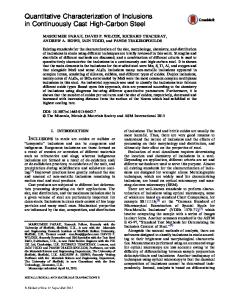Cavity sequences in continuously cast billets: Part I. Analysis of empirical data
- PDF / 291,307 Bytes
- 11 Pages / 612 x 792 pts (letter) Page_size
- 98 Downloads / 296 Views
I. INTRODUCTION
A BIZARRE chain of voids is found in the core of continuously cast steel billets. The shapes, volumes, and lengths of the cavities and their spacings fluctuate in an erratic manner. Figure 1 shows a typical example. Such central voids are unwanted because they can be associated with pronounced segregation of carbon and other elements. It is known that central porosity is basically due to the volumetric contraction of steel during solidification. Apart from this knowledge, many aspects of the phenomenon have remained mysterious: for example, the scattered appearance of the chain of voids and the dynamics of porosity formation. These are themes of the work described here. The previous literature has studied and characterized the central cavity. Mori et al.[1] were the first to classify porosity and segregation; they evaluated continuously cast sections ranging in size from 80 mm2 to 260 3 370 mm. Porosity depends strongly on the solidification microstructure; for columnar solidification, central pipes are the rule, whereas more variable porous patterns are found with an equiaxed morphology. A classification according to the type of porosity was given in Reference 2; the state of knowledge in 1980 was reviewed in Reference 3. Senk and co-workers[4,5] have presented charts of shrinkage holes and solidification structure for 105 mm2 billets. The distances between central pipes ¨ were found to be lognormally distributed[6]. Wunnenberg [7,8,9] and co-workers, using buoyancy weighing techniques, have elucidated the influence of casting conditions and steel grade on porosity. The mechanism of cavity formation has been explained by mini-ingot theory.[1,2,10] This intuitive model assumes that a local constriction in the range of final solidification disconnects a volume of liquid from the main pool; void is created when the blocked-off liquid shrinks during solidification. Constrictions may be caused by bridges of columnar dendrites[2] which grow faster than their neighbors. Another possible origin could be equiaxed crystals[3] that aggregate K.-H. TACKE, Head, is with the Department of Metallurgy, Max-Planck¨ ¨ Institut fur Eisenforschung, D-40237 Dusseldorf, Germany. Manuscript submitted June 12, 1998. METALLURGICAL AND MATERIALS TRANSACTIONS B
near the crater end and prevent further feeding. Also, nonsteady casting conditions can induce mini-ingots.[9] Strand stoppage, for example, leads to uneven shell growth; if protuberances of shell thickness persist until final solidification, they may become the cause of constrictions. Central voids can be artificially triggered by shooting nails into a billet near the crater end,[11] by intentional instationarity during casting,[9] or, in laboratory ingots, by a locally narrowed mold diameter.[12] Several countermeasures have been proposed against central porosity and segregation. Examples of these are electromagnetic stirring,[13–17] casting with low superheat,[18,19] sharp secondary cooling,[4,5] mechanical strand reduction,[20–23] and intensive cooling near the
Data Loading...











